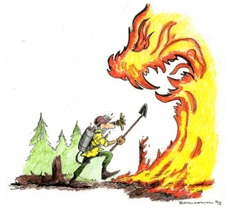
Basic Forest Fire Suppression Course - Online Lessons
LESSON 5 - FOREST FIRE SUPPRESSION
During the earliest stages of any fire, size up procedures and then quick Initial Attack must be completed to ensure the safety of crews and successful containment efforts. Once size up has been completed and it is safe for ground crews to start their job, the Initial Attack crew begins the containment effort. Some consideration are:
- Containment must be completed as quickly as possible. A break must be established around the entire perimeter (reducing heat as you go, but not trying to put the fire out as you go ) with the intention of containing the fire to its smallest size. Once the Initial Attack crews have control of the situation, the second phase (mop up procedures) can then begin.
- A hose line that is established around the perimeter must always be placed on the unburned fuel side of the line (in the green). A line placed inside the burn could rupture when too close to a heat source which would compromise the safety of crews who are depending on the water supply for their safety.
There are two methods of forest fire suppression: Indirect and Direct Attack. Whether one method is used over the other will depend on a variety of circumstances, however intensity levels, spread rates, type of initial attack equipment available will determine your choice. Direct attack can be used safely as long as intensity levels are low enough for crews safety.
Fire intensity indicates the degree of heat exhibited by the flames consuming fuel on a given piece of ground. A low intensity surface fire will display flame lengths that are small and do not appear to pose any hazard to ground crews. High intensity surface fire will display flame lengths that are over your head and give off a great deal of heat, making it uncomfortable for ground crews immediately adjacent to the fire edge. Knowing the intensity level or how much expended heat will provide a measure of safety for ground crews.
An approximate measure of frontal fire intensity can be determined by estimating flame length at the head. The numbers below are meant as a guideline for decision making purposes, however it must be cautioned that even at lower intensity levels, crew safety must always be a concern.
Flame length should not be confused with flame height. See glossary definitions.
- Flame length 3 m and less can be safely managed by ground crews
- Flame length 3 – 4.5 m require water bomber assistance (helicopter)
- Flame length over 4.5 m requires heavy water bomber assistance (fixed wing) or may be unmanageable.
A method whereby the fire is attacked immediately adjacent to the burning fuel. The most common example of this method is of a crew or machinery creating a fuel break directly beside the fire edge. To use this method, the intensity must be low enough to allow the fire fighters to get close to the fire’s edge. As we have already seen in the previous chapter a hose line or the back tank and shovel are often used in direct attack

Indirect Attack
In this method of attack, the fuel is separated from the path of the approaching fire. This technique is usually applied on high-intensity fires where fire fighters cannot approach the front of the fire due to heat and/or smoke conditions. An example would be the use of heavy equipment cutting line and allowing the fire to burn up to the break without burning over.
Water Application by Ground Crews
The concept of water application by a crew, is to first maintain their safety by applying water to areas of higher intensity levels and then continue to create a break (separating fuels) around the burn until it has been contained. There are two methods of water application that need to be used continually:
Parallel - Water is applied ahead of the crew and parallel to the line in areas where the intensity level is higher than the crew feels comfortable (flames are knocked down to remove the heat).
Right angle - A break or separation in the fuels is always maintained around the entire burn. This is done by the nozzle person on the crew working at the fire edge and applying water at right angles to the line creating a fuel break and extinguishing burning material as they go.